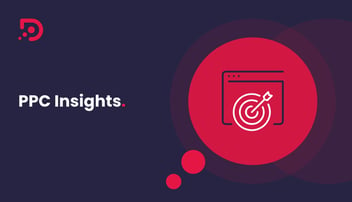The biggest mistake you can make with PPC is treating it as a fire-and-forget part of your marketing efforts. This can quickly lead to significant wasted ad spend, especially if your ads drive clicks but not conversions.
To minimise the risk of this situation arising, B2B PPC marketers need to put solid analysis and reporting processes in place. By laying out KPIs and using them to evaluate ongoing performance you can spot problems before they arise. You can also refine campaigns based on your learnings to further improve their performance.
In this article, we’ll tell you what you need to know about PPC analysis and reporting, including:
- The Importance of Regular PPC Analysis
- Essential Metrics Every Marketer Should Track
- Creating Comprehensive and Insightful Reports
- Common Pitfalls in PPC Analysis & Reporting
- Recommendations and Next Steps Post-Analysis
The Importance of Regular PPC Analysis
You’ve done your keyword research, written your ad copy, built your landing pages and set up your campaigns. You’ve established your key metrics and put things in place to track them. Now, regular PPC analysis is the final piece in this PPC puzzle.
Without analysis and reporting, the insights contained in the swathes of available PPC data go unnoticed and unactioned. Your campaigns are left to guesswork, and the likelihood of wasted spending increases.
With analysis and reporting, you keep abreast of campaign performance with reference to campaign goals. You can attribute successes to specific data points, and you can identify opportunities for improvement as and when they arise. You can also spot potential problems before they spiral out of control and incur large costs.
Essential Metrics Every Marketer Should Track
As a data-heavy marketing channel, PPC comes with many metrics you can track. Individually they reveal pertinent insights about campaign performance, but it’s when taken in combination that the real value starts to become apparent.
Below you’ll find 11 powerful PPC metrics with a top-level definition. We’ve explored these in more detail in our PPC tracking post, so take a look at them if you want to learn more.
- Quality score: Google’s ranking of your ad’s quality on a scale of 1-10
- Ad position: the position where your ad displays in the SERPs
- Impressions: the number of times your ad was seen in a specified time period
- Impression share: the ratio between impressions and opportunities
- Click-through rate (CTR): the ratio of impressions to clicks
- Cost per conversion (CPC): the average price you pay per successful conversion
- Cost per lead (CPL): the average price you pay for each verified lead
- Cost per mille (CPM): the average cost you pay per thousand impressions
- Conversion rate: the ratio of clicks to conversions
- Customer lifetime value (CLV): the average lifetime value of a customer acquired through PPC
- Return on ad spend (ROAS): total return on spend across the campaign
These metrics can be tracked in different ways. Some are available through Google Ads, others through Google Analytics, and others through third-party analysis and reporting platforms.
Creating Comprehensive and Insightful Reports
With so much data available, creating insightful reports can be a challenge. The temptation can be to throw all the metrics in, but this can quickly lead to an overwhelming document whose insights are hard to access.
We recommend keeping the following things in mind when creating reports:
- Who is the report for? Technical teams will have more interest in, and a greater capacity to understand, technical metrics and complex data. They’ll have a vested interest in engaging with the report contents and will use the insights to advise their work. Financial stakeholders on the other hand may just want top-line financial metrics to get an overview of whether or not the campaign is performing well.
- What data do you need to show? Some metrics - Ad Quality, for example - have little individual bearing on decision-making, as any insights they could reveal (low engagement rate, low CTR, etc.) are covered elsewhere. Choosing the right combination of metrics to convey the information you need will reduce the complexity of the document.
- What is the purpose of the report? Are you looking for input on future campaign direction? If so, metrics around engagement will be helpful in letting the reader understand the bigger picture. If you’re looking for signoff for continued spending, other metrics will be more appropriate.
Common Pitfalls in PPC Analysis & Reporting

Thanks to their potential complexity, there are a number of common pitfalls that PPC reports can fall into. These limit the ability of the report to articulately convey complex information, and as a result, limit its utility for decision-making and campaign refinement.
Here are five pitfalls to avoid when putting together your PPC reports:
You Don’t Have Clear Campaign Goals
Without clear campaign KPIs, reports are rudderless. A PPC report should show how your campaign is performing within the context of your goals, meaning these need to be clearly defined from the outset.
You’ve Included Too Much Data
As outlined above, throwing in every piece of data you can find just makes reports difficult to engage with. This is especially true when goals are absent and there’s no through thread.
You’ve Not Included Enough Commentary
Regardless of its quality, data means very little without commentary and context. A report is your opportunity to present the right data within context so that the people engaging with the report understand what the data represents.
You’re Over-Reliant On One Metric
As we’ve seen in the essential metrics section, individual PPC metrics only give one piece of the picture. If you’re proudly reporting on an excellent CTR but neglecting to mention the low conversion rate and ROAS, you’re limiting the ability of the person reading the report to build an accurate understanding of the campaign.
You’re Not Segmenting the Data
PPC performance can vary massively between devices (laptop vs. phone), between audience types, and even between days of the week. If you’re presenting your data as a single entity without mentioning the nuance provided by segmentation, you’re missing potentially significant insights that could advise with ongoing campaign configuration.
Recommendations and Next Steps Post-Analysis

All of the above is great to know, but you’re likely on the lookout for actionable insights to improve your PPC campaigns on the back of your analysis and reporting.
In this section, we’ll lay out some potential next steps for putting your PPC insights into practice.
Refine Your Strategy Based on Learnings
PPC reports are designed to advise ongoing campaign configurations, with the view to making changes that will improve performance over time. Even if you’re achieving your KPIs there is scope to make refinements that will strengthen future performance.
Here are some ideas:
- Refine your keyword lists: Are certain keywords performing better than expected, or vice versa? You can adjust lists accordingly to reallocate spending away from ineffective terms and towards effective ones.
- Refine your ad copy: Engagement metrics give a good insight into whether your ad copy is performing as intended, and making tweaks to headlines and descriptions to boost engagement is always recommended.
- Refine your landing page design: If engagement metrics are good but conversion metrics are lacking, this speaks to the need to strengthen your landing pages and help customers cross the bridge between click and conversion.
- Refine your CTAs: CTAs can be another weak link on the bridge between click and conversion, and tracking engagement with these specifically can inform adjustments.
- Refine your bid strategies: If you’re finding yourself spending too much on campaigns, you may want to adjust your bid strategy or bid limits to reign in spending a little.
Don’t Forget About A/B Testing
We discuss A/B testing in detail in our Comprehensive Guide to PPC Ad Copy, but to summarise:
A/B testing lets you compare different ad variations to see which performs best. By testing elements, reviewing test results, and refining ads accordingly … performance will be optimised over time, theoretically resulting in better conversions and higher ROI.
To truly unlock the insights of your PPC reports, A/B testing is crucial. It lets you formulate hypotheses based on the contents of the report, implement tests to see whether you can improve performance with planned changes, monitor the impact of the tests, and move ahead with the most beneficial course of action.
In Conclusion
Analysis and reporting is the final piece in the PPC puzzle. After you’ve invested time and effort in optimising keywords, bid strategies, ad copy and landing page design, reporting is a way to monitor performance with reference to your campaign goals and to strengthen campaign performance over time.
Collecting, presenting and decoding PPC data can be difficult thanks to the large volumes of data on offer and their complexity, but with the right knowledge and tools you can unearth powerful insights. Companies who take time to implement effective PPC reporting practices will stand themselves in better stead to succeed.
Still looking for more information about PPC Services? We’ve got you covered. Find out more through one of the article below:
- B2B PPC: What is it & Why is it Important?
- PPC Management: How to Optimise Your Ad Campaigns
- PPC Strategy: A Comprehensive Guide
- PPC Keyword Research: A Comprehensive Guide
- PPC Ad Copy: A Comprehensive Guide
- PPC Landing Pages: A Comprehensive Guide
- PPC Tracking: A Comprehensive Guide
- Why PPC Training Makes Sense for Marketing Managers
- How to Structure your PPC Campaign for Success
Or, why not check out our Definitive Guide to PPC Services.





